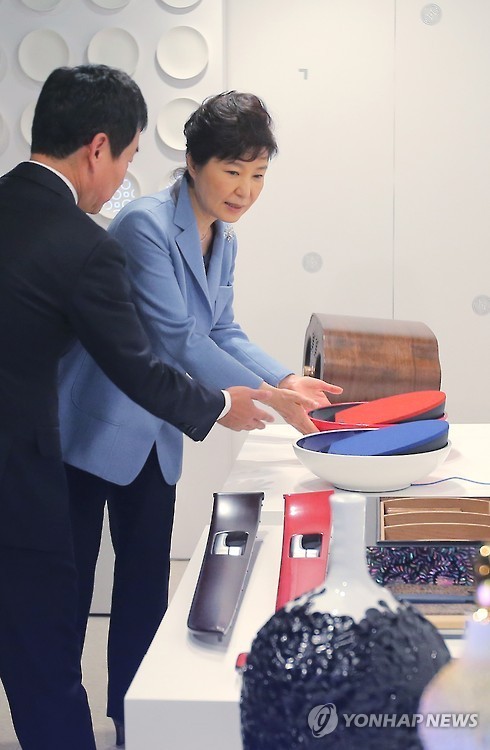The strains of “Arirang,” Korea’s unofficial national anthem, filled the air as President Park Geun-hye smiled at the National Marionette Theatre in Prague early this month, followed by Czech folk song “Humoresques.“
Titled “In the Attic,” the puppet show was the product of collaboration between the two countries’ artists ― traditional Korean pansori piece “Sugungga” formed the central music and story line under the command of a Korean director, while the rabbit and turtle marionettes playing the lead roles were made by Czech artist Jaroslav Dolezal.
“I believe if the strengths and traditions of the two nations’ cultures combine, it could produce more novel works and cultural contents that may spread throughout the world,” Park said after the performance.
Powered by the global K-pop craze, Seoul has been striving to promote Korean culture around the globe, seeking to turn it into a catalyst for greater trade and economic ties and people-to-people exchanges with other countries.
Titled “In the Attic,” the puppet show was the product of collaboration between the two countries’ artists ― traditional Korean pansori piece “Sugungga” formed the central music and story line under the command of a Korean director, while the rabbit and turtle marionettes playing the lead roles were made by Czech artist Jaroslav Dolezal.
“I believe if the strengths and traditions of the two nations’ cultures combine, it could produce more novel works and cultural contents that may spread throughout the world,” Park said after the performance.
Powered by the global K-pop craze, Seoul has been striving to promote Korean culture around the globe, seeking to turn it into a catalyst for greater trade and economic ties and people-to-people exchanges with other countries.

Upon her swearing-in in February 2013, she set “cultural enrichment” as one of the four top agendas of her statecraft, along with economic revival, welfare improvement and preparations for a unification with North Korea.
Under the plan, the Park administration pledged to jack up its spending on culture up to 2 percent of the budget, boost cultural opportunities across the nation and close the gap in access to cultural activities, promote cultural diversity, better preserve cultural assets, and cultivate the content industry in line with her drive for a “creative economy.”
It also launched a presidential committee to set and implement detailed goals and action plans. The 22-strong panel now chaired by art director Pyo Jae-soon held its first meeting with newly appointed members on Dec. 16.
Park, for her part, has proven to be the nation’s top culture ambassador herself on the world stage. Harnessing her easy charm as Northeast Asia’s first female president, she has been wearing traditional or modernized hanbok during overseas trips or international conferences, introducing cultural heritages to visiting foreign dignitaries and taking part in expos and major festivals.
Though most of her predecessors did participate in cultural events at home and abroad and sought to promote related sectors, Park is credited with newly defining culture’s foray into diplomacy.
Also in Prague, she attended the city’s first-ever K-pop concert where some 1,800 fans gathered from not only home but also other nearby central European countries such as Poland, Hungary and Slovakia. The lineup included boy band SHINee and girl group Red Velvet, as well as traditional Korean performances such as samulnori.
The four countries are the members of the Visegrad Group, with which Seoul has been striving to step up cooperation as part of what it calls middle power diplomacy aimed at raising its clout on regional and global conundrums by bridging the advanced and developing worlds. Park also had her first five-way summit with the V4 leaders during the visit.
While staying in Paris for the U.N. climate summit ahead of the Czech trip, she attended a Korean craft and fashion exhibition at the Decorative Arts Museum, looking around a spate of old-style craftworks such as lacquerware, mother-of-pearl works and celadon to contemporary graphic design and fashion items including the hanbok she wore on her inauguration ceremony, overseas visits and other occasions.
Cheong Wa Dae also made an unusual pick of the National Museum of Contemporary Art in downtown Seoul as the venue for an official welcome dinner during last month’s trilateral summit involving Chinese Premier Li Keqiang and Japanese Prime Minister Shinzo Abe.
During her travel to New York in September, Park became the first sitting president to visit an overseas Korean culture center since the country began opening the institutes in 1979. She turned up for a national brand fair and “K-Culture” event, browsing exhibits and attaching “best product” certificates to some articles. She also met with 16 “K-Culture” supporters selected by the center among renowned figures in the local culture, academic, sports and political circles and Korean War veterans, requesting them to play a “bridging role” between the two countries.
“Innovation is key to the creative industry and the government’s role is to help the players put out their creativity. Also for cultural content creators, agents and users, it needs to provide support while formulating a policy to ensure the Korean Wave’s sustainability,” said Kim Jae-beom, a professor in global business administration at Sungkyunkwan University’s Business School, at a seminar on cultural enrichment and economic strategy hosted by the Korea Chamber of Commerce and Industry on Dec. 16 in Seoul.
By Shin Hyon-hee (heeshin@heraldcorp.com)






![[From the Scene] Monks, Buddhists hail return of remains of Buddhas](http://res.heraldm.com/phpwas/restmb_idxmake.php?idx=644&simg=/content/image/2024/04/19/20240419050617_0.jpg&u=20240419175937)








![[From the Scene] Monks, Buddhists hail return of remains of Buddhas](http://res.heraldm.com/phpwas/restmb_idxmake.php?idx=652&simg=/content/image/2024/04/19/20240419050617_0.jpg&u=20240419175937)

![[KH Explains] Hyundai's full hybrid edge to pay off amid slow transition to pure EVs](http://res.heraldm.com/phpwas/restmb_idxmake.php?idx=652&simg=/content/image/2024/04/18/20240418050645_0.jpg&u=20240419100350)

![[Today’s K-pop] Illit drops debut single remix](http://res.heraldm.com/phpwas/restmb_idxmake.php?idx=642&simg=/content/image/2024/04/19/20240419050612_0.jpg&u=)